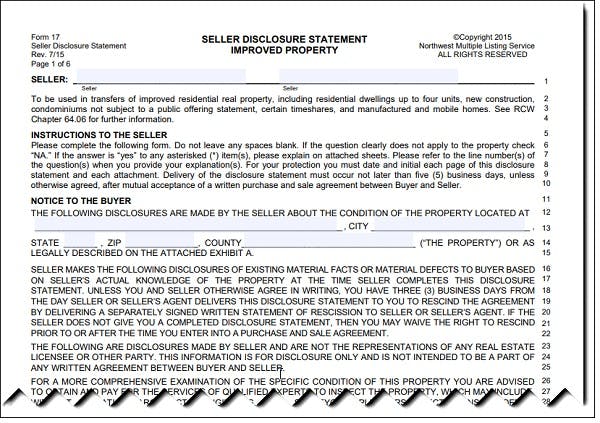Buyers who are serious about making an offer on a home often first ask their brokers to request a copy of the Seller Disclosure Statement. Although the seller does not have to give the statement until a purchase and sale agreement has been signed, it’s customary to have the seller complete the six-page document and deliver it to the listing (seller’s) agent as soon as possible.
A good seller’s agent will insist on having the statement completed well before offers arrive to ensure the information is available when buyers ask to review the document. (Seller Disclosure Statements are not required in foreclosure sales and when a Public Offering Statement for a condo would suffice, as well as other cases that are narrow in scope.)
The statement requires the seller to share his/her actual knowledge about the listed property. That includes the condition of the building(s), the availability of utilities, the existence of easements or other encumbrances, and other seller-known information. Many of the questions on the statement are marked with an asterisk. If he/she answers “Yes” to any of those questions, the seller is required by law to provide further details at the end of the form or on an addendum supplied by the listing agent.
A buyer’s broker will usually inform their clients that the disclosure statement is subjective and can lack depth regarding the condition of the property and building(s). Should they have any questions or concerns about the contents of the statement, buyers are advised to hire experts – including architects, engineers, electricians, among many others – to inspect the listed property and obtain an impartial report, backed by a professional, on the true condition of the property.
It’s important to note: Real estate brokers are not responsible for completing the disclosure form and sellers should not alter the document after completion. A listing agent can supply a separate form to note changes or corrections to the original disclosure statement and the notes must be in the seller’s words.
Neither the seller nor the listing agent will be liable to the buyer for inaccuracies in the statement, according to Washington state law, unless they had personal knowledge of the inaccuracies. Even if there is no specific question on the disclosure statement related to a known issue, the seller and listing agent must disclose the information in writing.
There are a few deadlines involving a Seller Disclosure Agreement that all parties should be aware of:
- The seller must ordinarily give the buyer the disclosure statement within five business days after the purchase and sale agreement is signed. Both parties may agree to a different timeline or the buyer may even agree in writing to waive the right to receive a completed statement (check with your real estate attorney before you do!) but there are two exceptions: a seller must share details to the Environmental section of the form when he/she responds “Yes” to those questions, and a seller must share a “material defect” in all cases.
- To address an error with the disclosure statement, the seller has the right to take corrective action – such as make repairs – at least three business days from closing to keep the statement accurate.
- The buyer has three business days from the day the seller’s agent delivered the disclosure statement to approve or rescind a purchase agreement and have earnest monies returned, but – as noted above – buyers usually see the document before making an offer. The buyer gets another three-day review of the statement should the seller amend information. He/she cannot rescind an offer after the purchase and sale agreement is signed by all parties.
Unless he/she waived the right to receive a completed statement, a buyer can rescind any offer if the seller fails to give the buyer the Seller Disclosure Agreement.
A good agent will help buyers navigate this sometimes-complex step in the process and remind you of important timelines. And, as always, seek the advice of a real estate attorney when in doubt.
If you read my previous blog post – Why You Need More Than Your Realtor ® for Advice – now you know why. If you didn’t read the post, please do so now.




